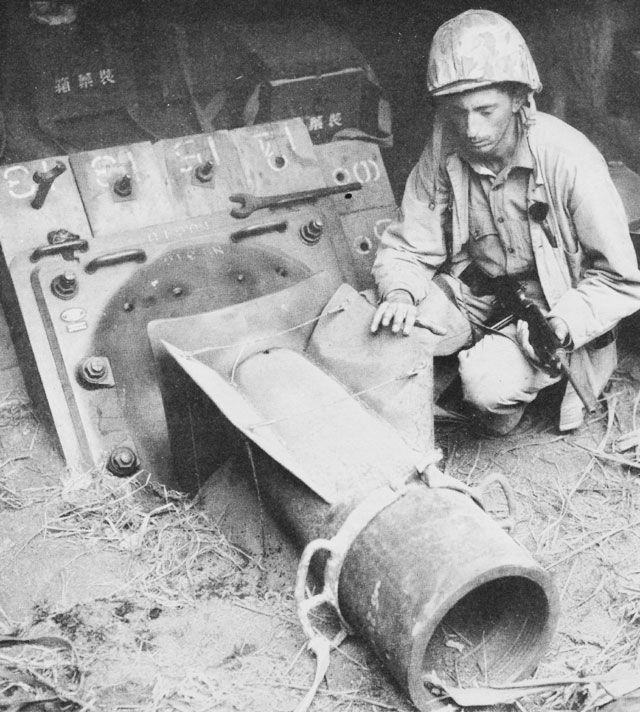Вот, из разных источников.
...
One of the unique Japanese weapons that Marines encountered on Iwo Jima was the 320mm spigot mortar. These enormous defensive weapons were emplaced and operated by the Japanese Army's 20th Independent Mortar Battalion.
The mortar tube, which had a small cavity at the muzzle, rested on a steel baseplate which, in turn, was supported by a wooden platform. Unlike a conventional mortar, the five-foot long projectile was placed over the tube instead of being dropped down the barrel. The mortar shell had a diameter of nearly 13 inches, while the mortar tube was little more than 10 inches wide. The weapon could hurl a 675-pound shell a maximum of 1,440 yards. The range was adjusted by varying the powder charge, while changes in deflection were accomplished by brute force: shoving and pushing the base platform.
Although the tubes only held out for five or six rounds, enough shells were lobbed onto Marine positions to make a lasting impression on those who suffered through that campaign. According to a platoon leader who served with the 28th Marines, the spigot mortar (referred to as "the screaming Jesus" in his unit) was always afforded a healthy respect and, along with the eight-inch Japanese naval rocket, remains one of his most vivid memories of Iwo Jima. General Robert E. Cushman, Jr., who commanded the 2d battalion, 9th Marines, at Iwo Jima and went on to become the 25th Commandant of the Marine Corps, recalled that the tumbling projectile's inaccuracy made it that much more terrifying. "You could see it coming," he said, "but you never knew where the hell it was going to come down."
...

...These were mentioned by my Great uncle who was a radioman for I company, 3rd Batallion, 383 Inf Regiment, 96th INF. Their first contact with what they called "Buzz bombs" THe shells were 320 mm (about 12.5 inches) and fired from a spigot mortar. THey carried several hundred pounds of explosive but were not designed to throw a lot of shrapnel, like a typical mortar and artillery shells. If they landed in soft ground like the rice paddies we were in, they made a big hole, but most of the explosive force was muffled by the dirt. However, as we found out later, if they landed in a rocky area they threw rocks like shrapnel and were very dangerous. Depending on the texture of the ground where they landed, they could make a hole about 30-40 feet across and 10-15 feet deep. These spigot mortars were used eextensively around KAKAZU but later in the campaign we didn't see much of them. I think the JAPS realized that their greatest effectiveness occurred when they could land the shells into rocky areas. Because of the size, and accompanying weight of hte spigot mortar itself, they must have been very cumbersome to move around and probably were used only in those areas where they had been emplaced before we landed. The accuracy was not very good, so the greatest damage would occur when they could catch us huddled up in rock areas. I don't think there were any casualties from the many shells they fired at us on the night of April 8th, 1945 at Okinawa...